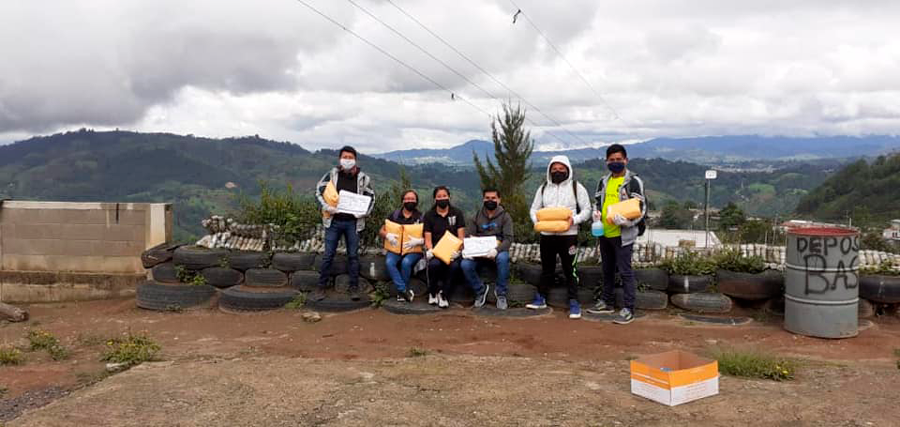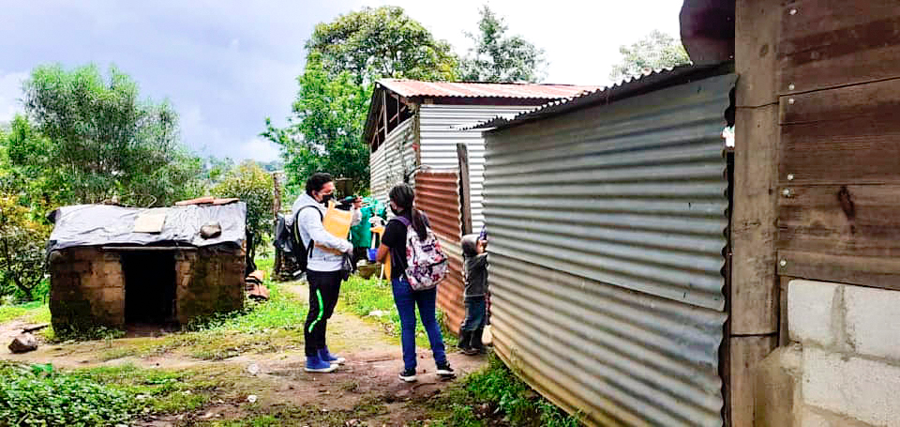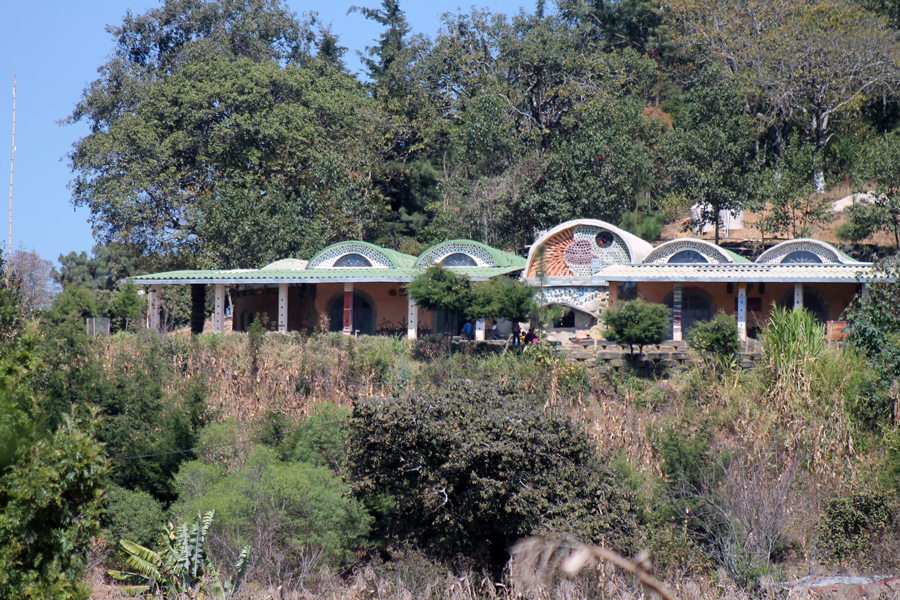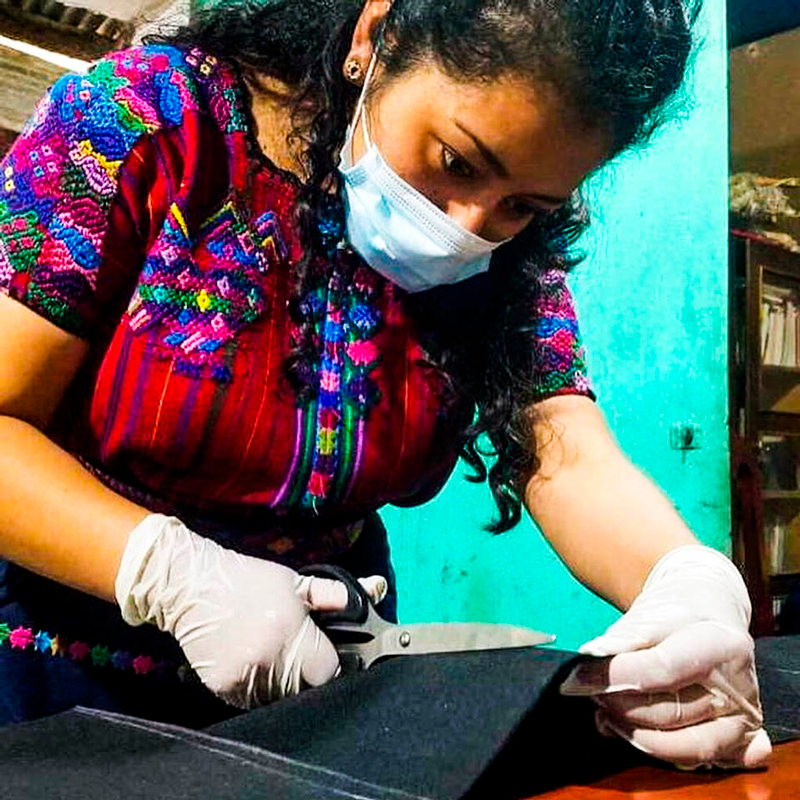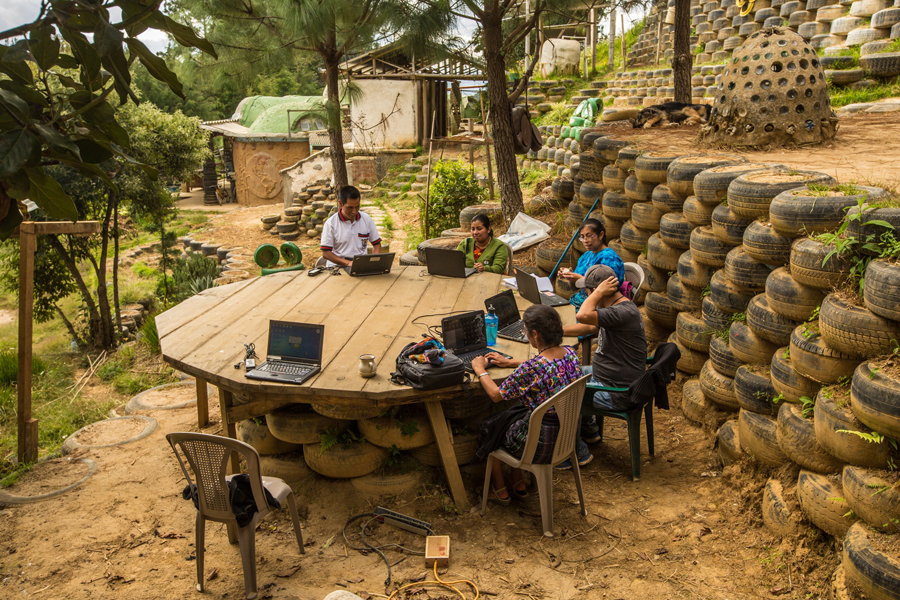Staff of the Long Way Home Hero School visit student homes during COVID-19
When the Guatemalan government of President Alejandro Giammattei instituted daily curfews, suspension of public transportation, closure of open marketplaces and schools, cancellation of all incoming flights and the prohibition of gatherings of more than 100 people to prevent the spread of COVID-19 those living in poverty were hit the hardest. Before the virus while over 59% of Guatemalans were estimated to be living in poverty, 80% of all indigenous were considered in poverty. Since the pandemic unemployment and hunger have increased.
Also, of concern during the pandemic has been the status of childhood education, especially in poorer indigenous areas. Even before the pandemic only 52% of children nationwide attended school after the sixth grade. With the closures of all schools on March 16, 2020 many children have been unable to return to some type of schooling. This has been the result of new demands on children to work with their parents and also the inability of schools to continue teaching.
Many schools turned to remote learning, but some students live without electricity in their homes or access to the Internet and computers. The faculty of the San Juan Comalapa K through 11th grade Hero School, operated by the non-profit Long Way Home, initially turned to WhatsApp for class communication.
“We started working with each student by sending them homework via WhatsApp, but we realized that 70% of students didn’t respond,” said Seño Mayra Azucena Cúmez Quiná, Hero School administrator. There were many reasons. She goes on to say, “One of [the reasons] was [the students] not having a smartphone, or not having enough money to be buying Internet data. This realization forced us to come to a new consensus with the teachers, to find a new strategy.”
Only 30 students from the total of 123 students enrolled in the project-based school own home computers and only 35 have access to smart phones. Teachers learned the majority of students could not be engaged online. They had to improvise. They began visiting each student’s home to deliver a printed workbook with homework and printed resources every two weeks. The teachers now move around the neighborhoods, visiting each student.
“The teacher goes to the house, delivers the guide, then the student has two weeks to work on it, and then in the same way we go back in two weeks to collect it and handout a new one,” said Seño Mayra. “Some families are so grateful that they invite the teachers into the home so that in this way the explanations can be best received by the student. However, we are always thinking of the necessary sanitary measures.”
This method is in contrast to the public sector where each family visits the school for the materials. Seño Mayra explains, “The difference in our modality is that we are going. As teachers we are responsible for going, turning in, collecting, and having a personalized interaction with them. Other private schools are working via social media, but our demographic has limited access, the majority of the families don’t have a computer or a smartphone to be able to access that information, and so that’s why we work with printed guides.”
These visits have allowed the student the opportunity to ask direct questions of the teacher. And for the teacher to know how each family is surviving the pandemic. This method has also allowed families in severe need to be noticed. At the beginning of the pandemic, a lexicon of distress appeared on the doorposts of homes: a white flag indicates hunger, a red flag calls for medicine, and black, blue or yellow flags mean a woman, child or elderly person is in danger of violence within the home. With many more families out of work banderos blancos, or white flags, have been rampant.
“Some colleagues noted the needs of families, one characteristic that of our community and of some families of the school, was that they put up the white flag. So, in that moment some teachers used their own money to raise money to buy some basics and they went and visited the family. So, it wasn’t done directly when we turned in the workbooks, but it was done when we saw the needs of the family by the part of some teachers at the Hero School,” said Seño Mayra.
In Comalapa, the pandemic has created severe economic consequences, as it has nationwide. Estimates are that 60% of families have lost employment or have experienced fewer job opportunities. It is estimated that 74% of Guatemalan families work in the informal sector and many jobs are related to tourism. Most live paycheck to paycheck and have no savings. When work ceases there is no cushion. Many field and domestic workers have been displaced as landowners returned to work their own fields and do their own household work.
Seño Mayra recalls a recent conversation, “I was speaking with one mother and she told me that she usually works as a domestic worker in a home, and she told me, ‘Seño, I’m no longer going to work, I occasionally will get a day of work just because the woman [of the house she worked at] wants to support my family, but now I’m not there the seven days a week like I had been doing.”
Vendors in the marketplace who have had their businesses suspended have improvised new kiosks in front of their homes or have offered refas, or snacks, through delivery. Others have offered to shop for other families, visiting the marketplace and delivering to the homes.
According to Seño Mayra, “For families of [Hero School] I know that sometimes whole families will go out to sell refas to houses, knocking door to door. Of course, this is risking their physical integrity, they could contract the virus, but they have taken this option of acquiring income for their family, to be able to meet their basic needs.”
The teachers at the school also began making masks to provide support to the community. “We started to make the masks through an initiative that Werner Bal, director of the school, suggested with the approval of Long Way Home for the budget of the masks,” said Seño Mayra.
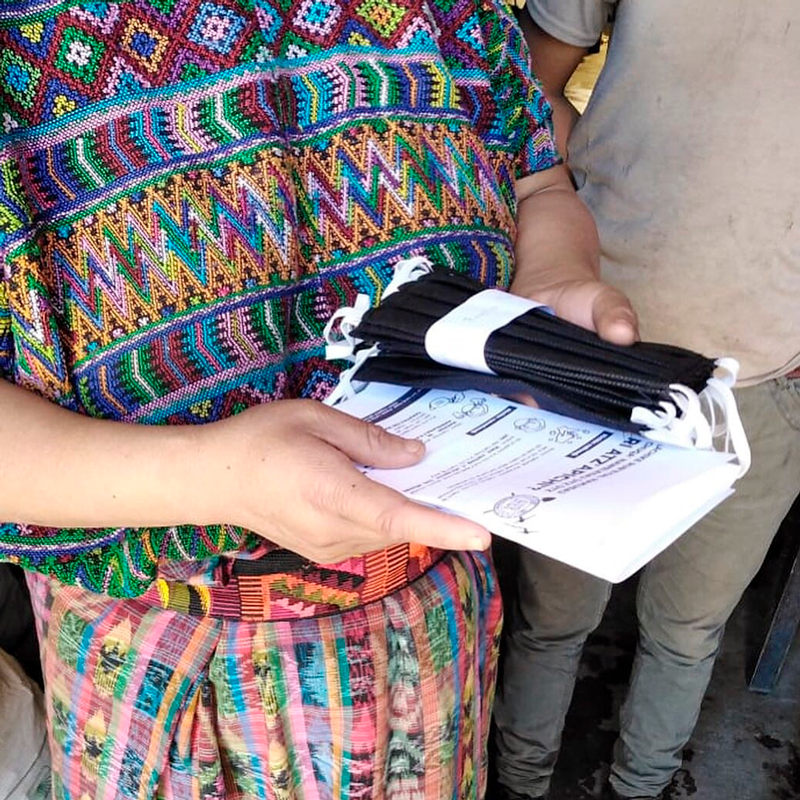 Hero School teachers disyributing masks and instructions
Hero School teachers disyributing masks and instructions
In April, the school calculated the number of available sewing machines within faculty members and began a massive mask-making operation. They were able to make 30 to 35 masks each day between eight sewing machines and a team of cutters.
Seño Mayra learned the necessary sewing skills to perfect the making of masks from her parents during this period. “Yes, as a matter of fact, when I started this experience of using the machine, I got exasperated but I had the direct support of my dad and my mom and they taught me. And I felt… really sheltered by them because they approached me with a lot of patience and taught me. And it was really beautiful to acquire this skill, the machine is there, in any moment one could use it, but why didn’t I ever have this push to use it? I had never used it. I wasn’t born knowing how to use it. When this project came up, I was obligated, and I remember when I started to sew I would get discouraged, because the thread would get tangled, or the needle would break, but through this I was able to learn how to change the needle, or when the thread would get tangled how to fill the bobbin And so it was really beautiful, all of this learning that I was able to acquire through the work of making the masks.”
The school has made 816 masks for the families of the Hero School and 1248 masks for the community of Xequin Sanaii, a poor community about 12 kilometers from Comalapa.
During this time Executive Director Matthew Paneitz has worked hard to improve the campus with new landscaping and other infrastructure improvements. “When the students return, they will be thrilled to see the reseeding of the soccer field, an actual waterfall which will be activated during the rainy season and many new flower varieties of shrubs. The closure of the school campus has allowed us to beautify everything for their return,” Paneitz said.
To hear and see Matt Paneitz speak about this opportunity for Long Way Home, click here.
Throughout this period, the staff and teachers of the Long Way Home Hero School have demonstrated resilience and adaptation by bringing learning to the students in their homes, making masks to improve health outcomes and create new beauty and functionality on the campus.
For more information about Long Way Home, please visit: www.lwhome.org
REVUE magazine article by Elizabeth Rose
